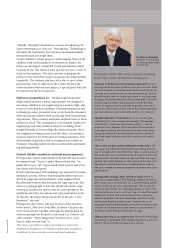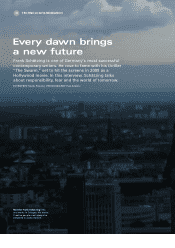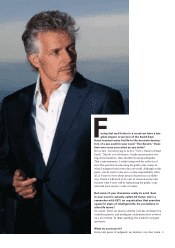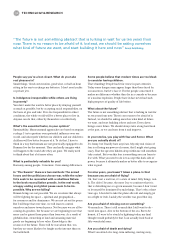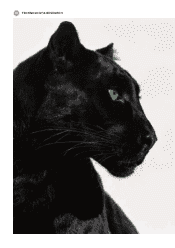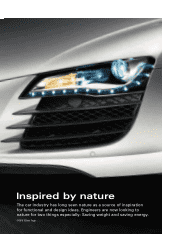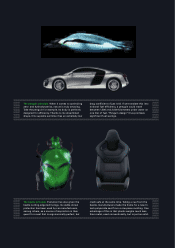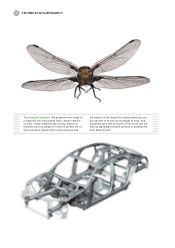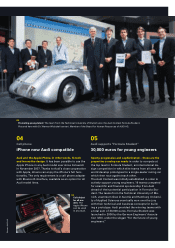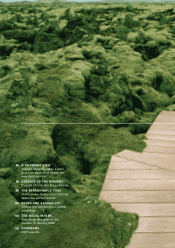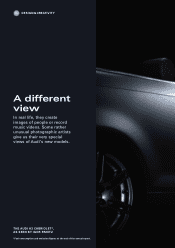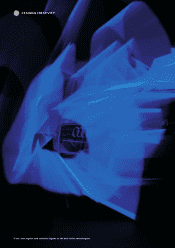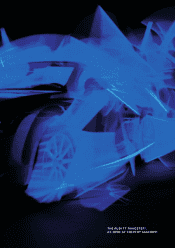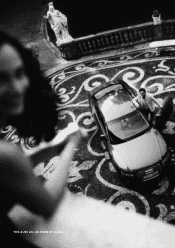Audi 2007 Annual Report Download - page 83
Download and view the complete annual report
Please find page 83 of the 2007 Audi annual report below. You can navigate through the pages in the report by either clicking on the pages listed below, or by using the keyword search tool below to find specific information within the annual report.
A steady drive for perfection: Audi’s
successful production system
Frank Dreves,
Member of the Board
for Production of
AUDI AG
What is it that makes car manufacturing sustainable?
It’s impossible to identify just one aspect. Rather, it’s
about the complex interaction of several factors. The
crucial goal is to manufacture and offer the customer
an attractive, premium-quality product at a competitive
price. This requires not only an attractive product de-
sign and superior features, but also optimal utilization
of the available manufacturing capabilities and the
establishment of efficient, supported manufacturing
methods, based on clear standards.
With the new A4, we have successfully implemented
the “turntable concept” between Ingolstadt and
Neckarsulm. This means that, for the first time, we can
completely produce a high-volume model at two loca-
tions, from the sheet metal deep-drawing stage right
through to filling up the tank for the first time. This
allows for a flexible response to changes in demand.
The integration of the Brussels plant into Audi’s pro-
duction network is another important step toward
achieving our strategic objectives. It provides us with
additional capacity and more flexibility in the produc-
tion of the A segment. In 2008, 84,000 vehicles will roll
off the production line at our fourth European site.
The small, compact Audi A1 will also be manufactured
exclusively at the Brussels plant, which could amount
to a production volume of as many as 100,000 units
per annum.
The Audi Production System is vitally important for
perfection – in terms of both quality and productivity.
To ensure a better response to growing requirements in
terms of ergonomics, productivity and flexibility, we
have systematically enhanced our Audi Production Sys-
tem. The key principles have been and remain consis-
tently making production processes worker-friendly
and clearly focusing on minimizing throughput time.
This allows us to establish clear standards as a basis
for developing a synchronized company that’s focused
on value creation. I firmly believe that when it comes to
expanding our product range, standardization is crucial
for success. This applies to processes and production
equipment, but also to the products themselves. Prod-
uct standards help us to develop our cars in such a way
that our colleagues on the lines can assemble them ef-
ficiently. They also help us to deal with the increasing
complexity caused by derivatization, and to meet our
customers’ demands for a varied product range while
maintaining premium quality.
result: Kerosene savings of up to three percent are possible –
which corresponds to 2.5 tonnes on a long-distance flight.
Spiders’ webs are a great example of the efficiency pres-
ent in evolution. Finer than human hair and stronger than steel
filaments, they are also more elastic than rubber. This is the
only way a spider’s web can withstand the impact of a beetle
in full flight, for example. This makes spider’s silk far superior
to any synthetic fiber such as nylon or kevlar. Its strength is
due to the long protein chains which the spider produces in
order to hold the web firm. Only recently have scientists man-
aged to create genetically engineered spider silk. The potential
of this high-performance material is limitless. Fireproof cloth-
ing is one possibility, as are bullet-proof vests. Hopes for the
medical field include extremely fine suture material for oph-
thalmic or neurological surgery, artificial tendons and replace-
ments for bandages, band-aid and casts.
At Audi, lessons learned from nature are not just applied
to the vehicles themselves – but also to the whole production
process. “We think in terms of improved functionality at our
plants and production facilities, but also in terms of workflow
organization,” says Koglin. Already in use are grips, clamps,
manipulators and tactile sensors able to detect the presence of
components. Vacuum grippers, for example, work on the
gecko principle. These lizards have billions of tiny hairs on the
soles of their feet, which gives them such perfect grip that they
can even walk hanging down vertically from flat surfaces.
The larger the animal, the finer the hair structure. The best
thing is that this adhesion can be loosened easily and without
leaving a trace, something that makes it extremely interesting
for industrial use. Gecko gloves could be useful for moun-
taineers or window cleaners. Researchers are also busy work-
ing on “gecko tape,” which should provide excellent adhesion.
Penguins and bats, geckos and spiders, bamboo and water
lilies – we are far from having discovered all the potential
Mother Earth has to offer. “Nature is like a magic fountain,”
says American biologist Edward Osborne Wilson, who last
taught at Harvard and was presented with the U.S.’s highest
scientific award. “The more we draw from the reservoir of
knowledge and opportunities that Nature has given us, the
deeper it becomes.”
Industry is certainly not the only area to benefit from bionic
research. It will also benefit the environment, since many
of the innovative solutions from the hi-tech laboratory that is
nature embody the principle of sustainability: After all, the
only solutions that have survived during the course of evolu-
tion are those that require minimal utilization of energy
and materials. •
Klaus Jopp, chemist and author, writes for Financial Times Deutschland,
WirtschaftsWoche, Stern and Bild der Wissenschaft.
Photos: digital vision/gettyimages, Bill Curtsinger/gettyimages, Massimo Fiorito/chipimages, recaro pr, fototo/blickwinkel, AUDI AG (3)
////////////////////////////////////////////////////////////////////////////////////////////////////////////////////////
////////////////////////////////////////////////////////////////////////////////////////////////////////////////////////
////////////////////////////////////////////////////////////////////////////////////////////////////////////////////////
////////////////////////////////////////////////////////////////////////////////////////////////////////////////////////
////////////////////////////////////////////////////////////////////////////////////////////////////////////////////////
////////////////////////////////////////////////////////////////////////////////////////////////////////////////////////


